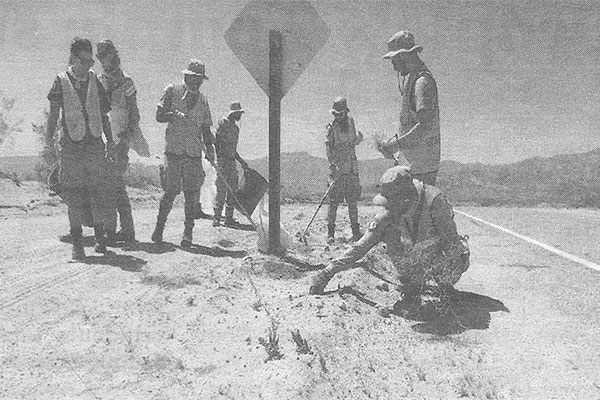
Tubb Canyon Desert Conservancy
News
February 2015
The Big Pull
“Saving the Wildflower Fields along Henderson Canyon Road”
By David Garmon
On Saturday, February 28th, the Tubb Canyon Desert Conservancy (TCDC) and AmeriCorps NCCC’s Silver 6 Team joined forces with the Anza-Borrego Desert State Park, ABF, and community volunteers to remove Sahara mustard from the iconic wildflower fields along Henderson Canyon Rd. Three years of draught have reduced the number of Sahara Mustard plants in these fields from hundreds, if not thousands, per acre to just a few dozen over the same area.
"In less than three hours, nearly 40 volunteers, with training and assistance from our AmeriCorps experts, cleared Sahara Mustard from approximately 160 acres where numerous species of wildflowers grow. This means that next year, instead of being threatened by ten times as many invasive weeds, the wildflowers can come back strong if the rain is abundant.
Just think what another hundred people can do this year and next over a few weekends and several square miles! Such community participation, from church groups to schools to dedicated individuals, can reverse Sahara Mustard’s threat to Borrego Springs and our local economy by ensuring that our spectacular wildflowers will continue to attract visitors from all over the world,” said TCDC vice president, Robert Staehle. “We encourage everyone interested in Borrego's natural beauty and economy to take part. Anyone can start with a visit to TCDC's website to learn more."
Megan Sanders, team leader for AmeriCorps NCCC Silver 6 Team, noted how gratifying it is for the team to be able to pass on to community volunteers the knowledge of Sahara Mustard the team has gleaned over the past two months. “We had never worked with invasive species before coming to Borrego Springs. Now, after two months, we are able to easily distinguish Sahara Mustard from its native lookalikes. It’s wonderful to be able to pass on what we have learned and to know this knowledge will be used by community volunteers long after we leave.”
Lori Paul, biologist and TCDC board member added, "Every Sahara Mustard plant pulled before it goes to seed this spring will prevent thousands of invasive mustard seeds from germinating next season. The volunteers that the AmeriCorps team taught to identify Sahara Mustard Saturday morning can now return to the fields and remove any remaining Sahara Mustard plants as they walk among the thriving wildflower blooms. They can also remove Sahara Mustard from their own properties and neighborhoods, and, in turn, teach others how to identify and eradicate Sahara Mustard wherever they see it.
With everyone's help and ongoing vigilance, Borrego Valley's wildflower fields can be saved."
For further information about Sahara Mustard, please see the Tubb Canyon Desert Conservancy website.
January 2015
Biodiversity and Invasive Species Network (BISN)
On Friday, January 30, 2015 the first meeting of the Biodiversity and Invasive Species Network (BISN) was hosted by UCI and the Tubb Canyon Desert Conservancy (TCDC) at the Steele Burnand Anza-Borrego Desert Research Center. The day-long meeting was attended by 35 members of the community, representing UCI, the Anza-Borrego Desert State Park; the Botany Society; AmeriCorps NCCC; TCDC; the Task Force, and interested community members.
David Garmon, MD, president of TCDC, began the meeting by extending a special welcome to the young men and women of AmeriCorps NCCC Silver 6 Team who are spending 10 weeks in Borrego Springs to assist with the eradication of Sahara Mustard. He also expressed special thanks to Audrey Steele-Burnand whose vision and generosity created the Research Center, thereby making the meeting possible.
Garmon elaborated a vision of the Anza-Borrego region as a “living laboratory of sustainability science.” He stated, “Our region is a microcosm of the grand challenges facing the rest of the globe. All parts of the world are now grappling with issues of water sustainability, air quality, preservation of biodiversity, economic development, and governance. These global challenges are the key issues facing the Anza-Borrego region, just on a smaller and more circumscribed basis. These challenges—our challenges—when combined with the mission of a great research institution such as UCI form the basis of sustainability science. Our community and our majestic state park are the laboratory in which these challenges will be studied and solutions found.”
Travis Huxman, Ph.D., Director of the Research Center and of the Department of Environmental Biology at UCI, spoke of the importance of creating a “knowledge network” of members of the community who are working for the preservation of biodiversity. “Within such networks information is shared that furthers the efforts of all participants,” he said. “Invasive species will always be with us. Our challenge is to discover new ways of responding that will preserve the range of biodiversity essential to our survival.”
During the day, interactive presentations were made around a number of projects occurring in the region in response to invasive species. Scot Martin of Anza-Borrego Desert State Park gave an overview of invasive species in our region and a detailed presentation regarding the efforts to rid the area of non-native tamarisk.
Frank Harris presented information regarding a new invader, Canary Island Knapweed, a newcomer that has the potential of being as destructive as Sahara Mustard, but in the United States is currently limited to a 5 mile radius within Borrego Valley.
Larry Hendrickson provided a historical perspective on Sahara Mustard; and UCI graduate student, Daniel Winkler, presented Phase I of a TCDC-backed initiative to identify a biocontrol agent for Sahara mustard.
The meeting concluded with recognition of the benefits to creating an ongoing network of communication among people working toward similar goals—the “knowledge network.” The participants also endorsed the idea of including members from beyond our region at the next meeting of the Biodiversity and Invasive Species Network (BISN).
November 2014 - February 2015
Taking Grassroots to the Capitol
Over the 90 days between mid-November and mid-February, more than 1400 people signed an online petition entitled “We don’t have to Sacrifice California’s Deserts for Renewable Energy.” The petition was authored by David Garmon, M.D., president of the Tubb Canyon Desert Conservancy (TCDC) and was circulated via the TCDC website.
The petition was in response to the publication of the draft Desert Renewable Energy Conservation Plan (DRECP) which would “streamline the siting of utility-scale electricity generating facilities” on hundreds of thousands of acres of desert habitat. Thousands of these proposed acres are just east of the Anza-Borrego Desert State Park and are referred to as Development Focus Areas. (See map.) The entire DRECP covers over 22.5 million acres, an area equal in size to the state of South Carolina.
The petition highlights UCLA’s Luskin Center’s July 2104 estimate of the generating capacity that already exists on rooftops in LA County alone. This UCLA report estimates the generating capacity on LA rooftops exceeds the 20,000 megawatts of generating capacity that would be “fast tracked” by the DRECP, and could be done without the need to build more 500 kV transmission lines.
On Thursday, March 26, 2015 Dr. Garmon delivered the signatures and comments of the petitioners to the offices of Governor of California (Jerry Brown), to the Chair of the California Energy Commission (Robert Weisenmiller), and to the Director of the Desert Renewable Energy Conservation Plan (DRECP) (Chris Beale).
“I requested a 15 minute meeting with the Director of the DRECP prior to going to Sacramento. I was therefore surprised and pleased to have been able to meet with Director Beale and the Governor’s DRECP Liaison, Terry Watt, for over an hour and a half,” Garmon said. “Although no promises were extracted, it is fair to say we had a ‘frank and earnest’ exchange of views during our meeting. In particular I emphasized our vehement opposition to the siting of utility-scale generating facilities in the deserts of California and our strong support of distributed, in-basin generation, aka rooftop solar.”
During the 135-day public comment period that closed February 23, 2105, the California Energy Commission (CEC) received over 12,000 comments in response to the 10,000-page DRECP. According to Director Beale many of these comment letters echoed the theme of fully developing rooftop solar in LA and San Diego Counties before building utility-scale facilities in the desert. Many of the comment letters emphasized environmental consequences of utility-scale facilities in the desert such as groundwater depletion in areas with already “stressed” or “over-drafted” aquifers and degradation of air quality. Other, highly technical letters noted flaws in the public notification process as well as the plan’s inadequacies from the standpoint of the National Environmental Policy Act (NEPA) and the California Environmental Quality Act (CEQA).
Mr. Beale did not provide an estimate as to when the process of evaluating and incorporating the public comments would be completed, nor when the final plan would be submitted to the state (CEC, CA Fish & Wildlife) and federal (BLM, US Fish & Wildlife) agencies for their approval.
September 2014
Sahara Mustard Eradication Research Advanced by $50K Gift
A $50,000 gift to a non-profit conservancy will launch research designed to lead to the discovery of biocontrol agent(s) for invasive, non-native Sahara Mustard (Brassica tournefortii). The gift was received from Audrey Steele-Burnand, a long-time supporter of innumerable organizations and activities in Borrego Springs and Southern California. The recipient of the gift is Borrego Springs-based Tubb Canyon Desert Conservancy (TCDC), established in 2011 to conserve the natural beauty and resources of the Anza-Borrego region and desert Southwest.
“This gift completes our fundraising efforts for Phase I of TCDC’s Biocontrol Program aimed at finding a solution to the threat posed by invasive Sahara Mustard to Borrego Springs, as well as to the vulnerable deserts of the American Southwest,” said David Garmon, M.D., president and a founding director of TCDC.
Sahara Mustard is originally from the Sahara Desert and Mediterranean basin; it was accidentally introduced into California’s Coachella Valley in the 1920’s. In the deserts of the U.S., Sahara Mustard outcompetes native flora, and in the span of 90 years has spread from the coast of California to the deserts of West Texas, and from Utah into Central Mexico. By germinating and growing very rapidly after rare desert rains, under the right conditions, Sahara Mustard plants grow foliage that quickly shades out native annual wildflowers and cacti. “This invasive species blocks the sunlight and steals the water needed by native wildflowers, cacti, and flowering shrubs that make our desert so beautiful in the Spring,” said biologist Lori Paul, a TCDC founding director. “A single plant can produce from ten to ten thousand poppy-like seeds in three months, creating an exponential takeover of acres of wildflowers over a few years’ time,” she said.
There are vast swaths of desert in the southwestern United States that have been completely overrun with Sahara Mustard, so much so that researchers from Northern Arizona University have begun using satellite imagery to track the devastation this invasive plant has wrought on hundreds of thousands of acres of desert habitat.
While diligent hand-pulling has proven effective over small, circumscribed areas and along some roadsides, biocontrol is seen as the only viable option for addressing the threat posed by Sahara Mustard in the thousand square mile Anza Borrego Desert State Park and in the vast deserts of the American Southwest.
Working in partnership with Dr. Travis Huxman, Director of Environmental Biology, University of California, Irvine and Director of the Steele/Burnand Anza-Borrego Desert Research Center in Borrego Springs; Dr. Jon Rebman, Curator of Botany at the San Diego Natural History Museum; Carl Bell, Professor Emeritus, University of California; and the USDA European Biological Control Laboratory in Montferrier-Sur-Lez, France; TCDC has formulated a three-phase approach to the identification and testing of biocontrol agents for Sahara Mustard.
“The recent availability of rapid and inexpensive DNA sequencing decreases the cost of this effort by an order of magnitude and decreases the time it will take to locate potential biocontrol agent(s),” explained Dr. Garmon, whose undergraduate work was in molecular biology at Princeton University. “Phase I of the program involves defining the genome of ‘our’ local Sahara Mustard. Phase II involves defining the genomes of the various populations of Sahara Mustard in its native range in the Old World. Phase III will use the information developed in Phases I and II to look for a genetic match of the Sahara Mustard found in the U.S. with a specific population of Sahara Mustard in the Old World. Once that match is made we will know exactly where to begin Phase III, which will be the identification of the biological agents that limit the spread of ‘our type’ of Sahara Mustard in its native range. Once identified, potential biocontrol agents will undergo rigorous testing for safety and efficacy in quarantined laboratories in Europe and the US.”
“This is a large project and we have a long way to go,” Garmon noted. “I am forever grateful to Audrey Steele-Burnand for her generosity and for her awareness of the magnitude of the threat this invasive species poses not just to the Borrego Springs community, but to all deserts of the American Southwest.”
For more information about the Tubb Canyon Desert Conservancy and how you can participate in this effort, please go to the TCDC Sahara Mustard Biocontrol Project.
March 2014
Thank You! AmeriCorps Silver 6
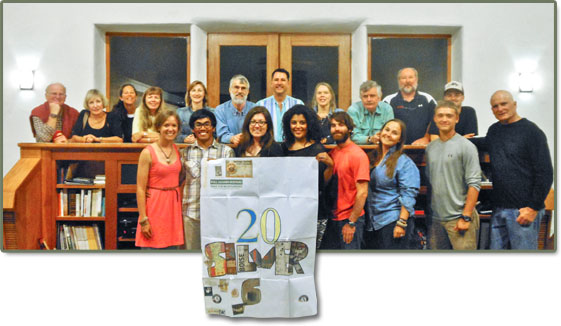
Photo courtesy of the Anza-Borrego Foundation.
On Friday, 21 March 2014, we gathered to say goodbye to our AmeriCorps Silver 6 team upon completion of their work in Borrego Valley and the Anza-Borrego Desert. A farewell dinner for the team was graciously hosted by Anza Borrego Foundation (ABF) Board Member, Dick Troy, in his beautiful Borrego Springs home. In attendance were members of the TCDC and ABF Boards, as well as Anza-Borrego Desert State Park staff. The next day the Silver 6 team left for Sacramento where they will prepare for their next assignement in Northern California.
The sign made by the team reflects the 20th Anniversary of AmeriCorps.
Silver Six, you did an incredible job eradicating Sahara Mustard and reaching out to visitors and our desert community. You set a very high bar for future teams! We will miss you all. Good luck with the rest of the year... and keep on dreaming!
(— David Garmon, TCDC President)
July 2013
TCDC Winner of 2013 AmeriCorps
Sponsor of the Year Award, NCCC Pacific Region
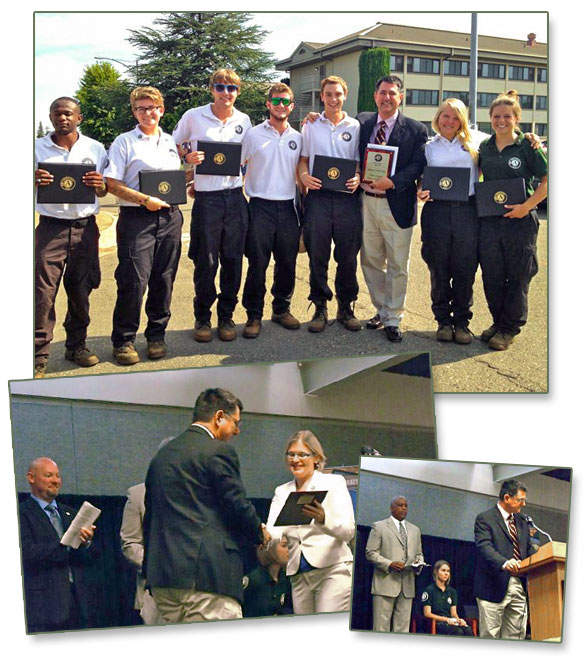
The winner of the 2013 AmeriCorps National Civilian Community Corps (NCCC) Pacific Region’s Sponsor of the Year Award was the Tubb Canyon Desert Conservancy (TCDC).
In accepting this award TCDC President, J. David Garmon, MD said to the graduating class,
“I am honored to accept this award on behalf of the many, many people in Borrego Springs who worked to make our project successful. In particular, I am grateful to our co-Sponsor, the Anza Borrego Foundation, and to the superintendant and rangers of the Anza-Borrego Desert State Park. These friends, along with representatives of schools, churches, and businesses, as well as private individuals, were at the heart of our project—a project that could not have been successful without the participation of each and every one of them.
I would also like to say is how honored I feel to be a part of AmeriCorps. Your mission of service to the Nation is a beacon of hope and inspiration for all who witness it. Your hard work—whether in the field or in an office— is greatly appreciated; but it is your innumerable acts of service that are truly remarkable and that set you apart from your peers. I am very proud to be in your company.”
The award was part of the 19th annual graduation ceremony of AmeriCorps NCCC that was held this year at AmeriCorps Regional Headquarters at McClellan Air Force Base in Sacramento on July 22, 2013. In the weeks leading up to the ceremony, AmeriCorps team members and staff submitted nominations for Sponsor of the Year from among the approximately one hundred Project Sponsors throughout the western United States, Alaska, and Hawaii. Regional AmeriCorps leaders then evaluated nominees according to numerous criteria including how well projects reflected AmeriCorps’ core value of service, provided exceptional learning opportunities for team members, and integrated the project with the needs and goals of the community at large.
TCDC is a 501 (c)(3) non-profit (www.tubbcanyondesertconservancy.org) that was formed in 2011 by neighbors in the Tubb Canyon area. Its mission is to support education about, research into, and eradication of Sahara Mustard. For each of the last two years TCDC has sponsored an AmeriCorps team that has worked in the Borrego Valley eradicating Sahara Mustard from both private and public lands
April 2013
Americorps NCCC group helps ABDSP with mustard eradication

Americorps
NCCC Team
Blue 6 pulls the
Sahara Mustard
Weed for 8-9
hours day, 5
days a week.
Here they work
the shoulder of
the road on route
S-22 just before
Font's Point.
The Tubb Canyon Desert Conservancy group along with the Anza-Borrego Desert State Park and the Anza-Borrego Foundation has been hosting an Americorps NCCC group of young people, that are here to help assist protect our valley from the hostile takeover of the Sahara Mustard Weed. So far the Americorps group has pulled about 156 acres in Tubb Canyon and about 3 miles of road shoulder in the state park on route S-22.
Americorps NCCC (National Civilian Community Corps) is a full-time, team-based residential program for men and women age 18- 24, that helps to strengthen communities and develop leaders through direct, national and community service.
The team here in Borrego Springs have been gathered from all over the Midwest and east coast. After being through several projects in.. other parts of America, they still workhard here in the valley to pull as much mustard as possible and help stop the spread of the weed throughout Borrego and our surrounding state park.
Team Leader Ryan Gugerty said that the theory is the seeds first arrived with the Date Palms here in Borrego. He also mentioned that Sahara Mustard is the largest invasive issue in the southwest.
The reason these invasives are so problematic is because they evolve where their natural predators are different than the environment they are currently in, so now they may not have any natural dangers. Gugerty said that the mustard would create a mono culture, in other words sand and mustard.
Because these weeds are so invasive the mission sometimes feels hopeless and people may fail to see the purpose, but TCDC and the Americorps group only wish to reduce the seed bank and help stop the spread from continuing.
The Sahara Mustard Weed may never fully leave the valley.
To learn more about the Sahara Mustard Weed and how you can protect our desert visit www.TubbCanyonDesertConservancy.org.
— Borrego Sun (Posted 4-25-2013)
February 2012
AmeriCorps Crew hopes to recruit local groups to pull mustard plants
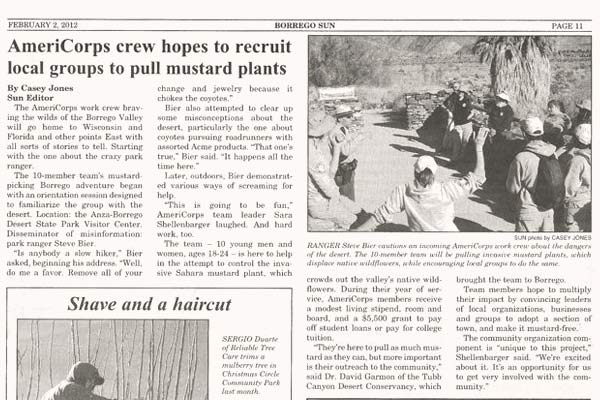
The AmeriCorps work crew braving the wilds of the Borrego Valley will go home to Wisconsin and Florida and other points East with all sorts of stories to tell. Starting with one about the crazy park ranger.
The 10-member team's mustard-picking Borrego Adventure began with an orientation session designed to familiarize the group with the desert. Location: the Anza-Borrego Desert State Park Visitor Center. Disseminator of misinformation: park ranger Steve Bier.
"Is anybody a slow hiker," Bier asked, beginning his address. "Well, do me a favor. Remove all your change and jewelry because it chokes the coyotes."
Bier also attempted to clear up some misconceptions about the desert, particularly the one about coyotes pursuing roadrunners with assorted Acme products. "It happens all the time here."
Later, outdoors, Bier demonstrated various ways of screaming for help.
"This is going to be fun," AmeriCorps team leader Sara Shellenbarger laughed. And hard work, too.
The team — 10 young men and women, ages 18-24 — is here to help in the attempt to control the invasive Sahara mustard plant, which crowds out the valley's native wildflowers. During their year of service, AmeriCorps members receive a modest living stipend, room and board, and a $5,500 grant to pay off student loans or pay for college tuition.
"They're here to pull as much mustard as they can, but more important is their outreach to the community," said Dr. David Garmon of the Tubb Canyon Desert Conservancy, which brought the team to Borrego.
Team members hope to multiply their impact by convincing leaders of local organizations, businesses and groups to adopt a section of town, and make it mustard-free.
The community organization component is "unique to this project," Shellenbarger said. "We're excited about it. It's an opportunity for us to get very involved with the community."
— By Casey Jones Borrego Sun Editor (Posted 3-9-2012)
January 2012
AmeriCorps Arrives with the Wind
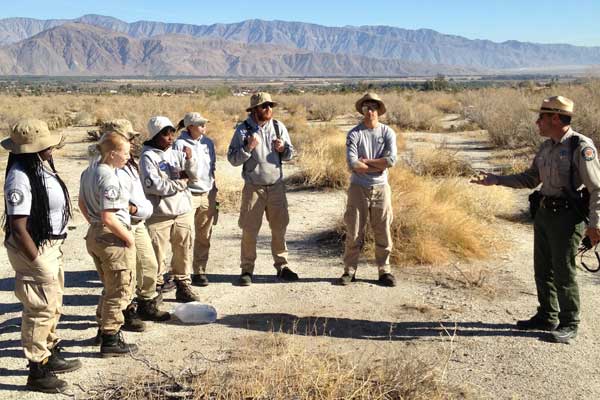
AmeriCorps NCCC and Ranger Steve Bier orientation
The AmeriCorps NCCC—Pacific Regions’s Silver 5 team, aka Silver Cinco, arrived in the Borrego Valley on schedule on Thursday, January 19th. The team is composed of 10 young adults from all around the US, and is lead by Sara Shellenbarger, a recent graduate of Hamline University. Upon arrival in the valley, the team set up in a campground made available by the State Park.
On the morning of their first full day in the valley, Friday, January 20th, the team gathered at the Visitors Center at the Palm Canyon Campground for orientation. I provided an overview of the Sahara Mustard problem confronting the Borrego Valley, as well as the eradication project upon which the team would be embarking. Ranger Steve Bier gave an en“gross”ing (I know he wouldn’t mind me saying that) presentation on desert safety, followed by Larry Hendrickson who gave a detailed presentation of the evil mustard itself.
After a tasty lunch at Calico’s the team headed to Plum Canyon for its first hands-on experience with Sahara Mustard. Although there was mustard to be found (and exterminated!) at Plum Canyon, the plant was not present in the same profusion as last season. The same is true in Tubb Canyon. Although a few plants can be seen developing under the dead remains of last year’s growth, they are small—2 to 3 inch diameter rosettes—and have not yet begun to flower. One member of the team wondered if the lack of mustard this season was God’s way of apologizing for what he did to us last season. Personally, I’ve always found it nearly impossible to divine what that Guy is thinking.
Friday, January 20th ended with a welcoming dinner at the Krazy Coyote at the Palms at Indianhead. The 10 AmeriCorps members were joined by five TCDC Board Members, three State Park representatives—Paul Johnson, Bob Theriault, and Larry Hendrickson—as well as ABF Executive Director Conrad Kramer and his wife, Lisa. The staff of the hotel created a warm atmosphere to the delight of all.
The following day, Saturday, January 21st was a day off for the team—a time to relax and to explore the beauty of the Borrego Valley. As can be seen in the following photo, the day started off with great promise—reminiscent of that Great Promise that He would never wipe humanity out again……with water.
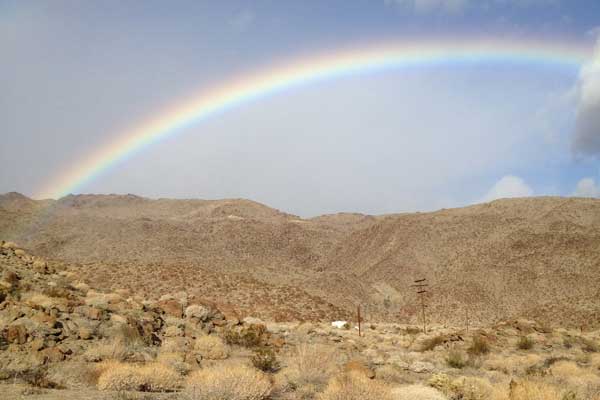
Rainbow greeting the AmeriCorps on January 21st.
The morning was spectacular with billions of tiny water droplets being gently blown over Pinyon Ridge to form brilliant rainbows. By noon the breeze had picked up considerably, but no more than a good Borrego blow. By mid-afternoon the wind was howling and things that don’t ordinarily move around began to shake, e.g. roofs, carports, awnings, etc. By 3PM the things that had been shaking gave way and launched themselves into the air. By 3PM the air was so thick with dust that previously visible mountains disappeared.
Shortly after 3PM I received a voice mail from Sara, the leader of Silver 5, saying their tents in their base camp had collapsed and that they would have to abandon their campsite. As there is no cell service in the campground, I drove there as fast as possible to find the team leader and one other team member, Randal Domer—the rest were still in town—stowing gear in the cargo van as quickly as humanly possible. Amid wind howling in the trees and thunderous cracks and crashes of huge limbs, the three of us stowed gear and got the Hell out of Dodge.
We met the remainder of the team at The Palm Canyon Resort where TCDC Board members Lori Paul and Rob Staehle had arranged rooms for the team for the night. By this time, around 5PM, the wind was beginning to subside, but damage was evident all over town: trees were down, electric power was out in many places, debris was everywhere, and roofs and carports had become twisted pieces of wood and metal.
Thanks to the gracious staff of The Palm Canyon Resort, the team spent a comfortable night out of the wind and away from falling branches. Hot showers washed away the dust that had coated everything and everyone.
The next day we learned that this was no ordinary windstorm. This storm had sustained winds of 60 mph with gusts to 90 mph. No wonder the roofs were blown off and the tents collapsed. The team is now temporarily ensconced in the ranger’s house at Tamarisk Grove until new tents can be sent to the team from Sacramento.
What a welcome to the Borrego Valley!
I will keep you updated with the team's activities over the next two months. Follow the weekly adventures and mustard busting work of the AmeriCorps Silver Cinco Team on the AmeriCorps Team Updates page!
(—David Garmon, Posted 01-27-2012)
Chamber president shouldn't stick his head in sand
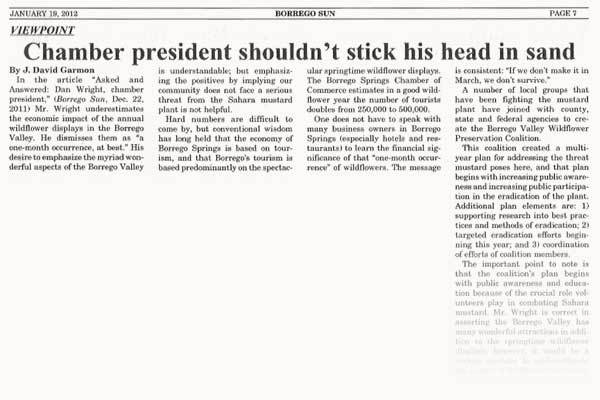
By J. David Garmon
In the article "Asked and Answered: Dan Wright, chamber president," (Borrego Sun, Dec. 22, 2011) Mr. Wright underestimates the economic impact of the annual wildflower displays in the Borrego Valley. He dismisses them as "a one-month occurrence, at best." His desire to emphasize the myriad wonderful aspects of the Borrego Valley is understandable; but emphasizing the positives by implying our community does not face a serious threat from the Sahara mustard plant is not helpful.
Hard numbers are difficult to come by, but conventional wisdom has long held that the economy of Borrego Springs is based on tourism is based predominantly on the spectacular springtime wildflower displays. The Borrego Springs Chamber of Commerce estimates in a good wildflower year the number of tourists doubles from 250,000 to 500,000.
One does not have to speak with many business owners in Borrego Springs (especially hotels and restaurants) to learn the financial significance of that "one-month occurrence" of wildflowers. The message is consistent: "If we don't make it in March, we don't survive."
A number of local groups that have been fighting the mustard plant have joined with county, state and federal agencies to create the Borrego Valley Wildflower Preservation Coalition.
This coalition created a multi-year plan for addressing the threat mustard poses here, and that plan begins with increasing public awareness and increasing public participation in the eradication of the plant. Additional plan elements are: 1) supporting research into the best practices and methods of eradication; 2) targeted eradication efforts beginning this year; and 3) coordination of efforts of coalition members.
The important point to note is that the coalition's plan begins with public awareness and education because of the crucial role volunteers play in combating Sahara mustard. Mr. Wright is correct in asserting the Borrego Valley has many wonderful attractions in addition to the springtime wildflower displays; however, it would be a serious mistake to underestimate the impact of the wildflower tourism on the economy of Borrego Springs, or to underestimate the importance of public awareness and public partipation in the protection of native habitat from destruction by Sahara mustard.
J. David Garmon, M.D., is president of the Tubb Canyon Desert Conservancy which formed in 2011
(Posted 01-19-2012)
November 2011
Mustard weed has a new enemy: Tubb Canyon Desert Conservancy
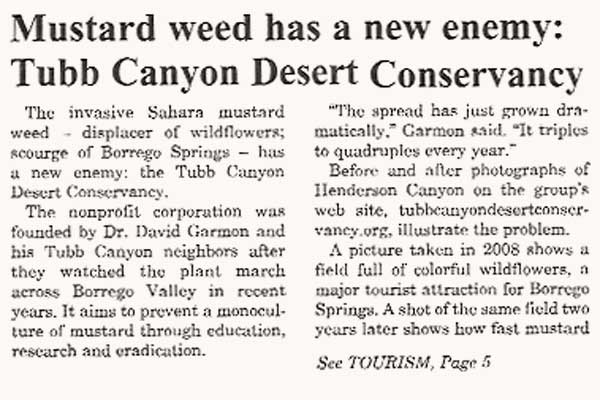
The invasive Sahara mustard weed - displacer of wildflower; scourage of Borrego Springs - has a new enemy: the Tubb Canyon Desert Conservancy.
The nonprofit corporation was founded by Dr. David Garmon and his Tubb Canyon neighbors after they watched the plant march across Borrego Valley in recent years. It aims to prevent a monoculture of mustard through education, research and eradication.
"The spread has just gorwn dramatically." Garmon said. "It triples to quadruples every year."
Before and after photographs of Henderson Canyon on the group's web site, tubbscanyondesertconservancy.org illustrate the problem.
A picture in 2008 shows a field full of colorful wildflowers, a major tourist attraction for Borrego Springs. A shot of the same field two years later shows how fast mustard... (continued below)
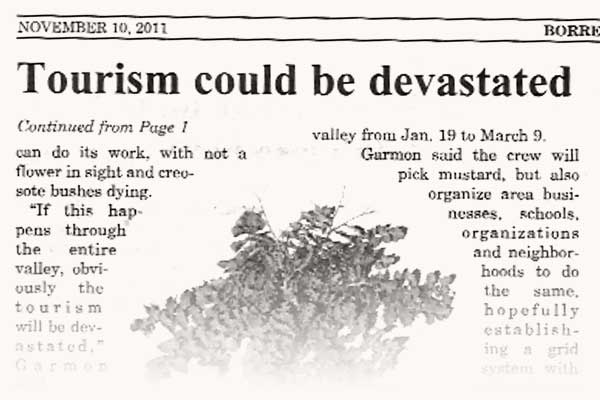
can do its work, with not a flower in sight and creosote bushes dying.
"If this happens through the entire valley, obviously the tourism will be devastated," Garmon said.
Plus Garmon said, mustard grows so prolifically that, when the plants die, fuel quickly accumulates on the desert floor.
"The wildfire threat will be dramatically enhanced." Garmon said. "Many of us feel the future of Borrego Springs is at stake."
Last March, Garmon and friends tried a hands-on approach to fighting mustard in Tubb Canyon, pooling their resources and hiring a work crew that removed 750 large garbage bags of the plants.
The effort, which cost $2,500 for labor alone, made the neighbors realize that a more far-reaching approach, and a lot more money, would be needed to make headway against the plant.
"We realized if we were to be successful, we would have to form a non-profit," Garmon said. "Organizations and agencies don't give grants to a handful of neighbors."
So far, so good. The conservancy has secured a federal AmeriCorps grant to bring 8-12 mustard fighters/community organizers to the valley from Jan. 19 to March 9. Garmon said the crew will pick mustard, but also organize area businesses, schools, organizations and neighborhoods to do the same, hopefully establishing a grid system with assigned mustard-pulling stations throughout the valley. He compared it to the "Adopt a Highway" model.
These short-term efforts, while labor intensive, are needed to hold the plant in chock while scientists explore methods of eradicating it.
Medium-range solutions, Garmon said, center around herbicides. The conservancy has provided land for research in Tubb Canyon, hoping the UC Cooperative Extension can find the right mix of herbicides, and the proper timing, to kill mustard without also killing the flowers. It acquired a $7,000 grant from the Desert Protective Council to help underwrite the research.
The long-term solution, garmon said, "has to be biocontrol. We need a parasite, a virus, a bacteria; something we can introduce into the environment to control the mustard."
Until then, Garmon advises residents to keep pulling all the mustard weeks they can. "If we let it grow unchecked, the whole valley will be like Henderson Canyon."
— By Casey Jones (Posted 11-10-2011)
TCDC Awards Grant to University of California, Cooperative Extension
The Tubb Canyon Desert Conservancy (TCDC) is proud to announce that it has awarded its first research grant of $7,000 to Dr. Chris McDonald of the University of California, Cooperative Extension. This grant will be used to support Dr. McDonald's research into large-scale eradication of Sahara Mustard during the 2011-2012 growing season. Dr. McDonald has performed preliminary research into methods of Sahara Mustard eradication during the 2010-2011 growing season. The results of that study can be viewed on the Sahara Mustard Consortium's Research Updates page.
David Garmon, President of TCDC said, "Our grant to The University of California, Cooperative Extension will support the only research project into large-scale eradication of Sahara Mustard occurring during the approaching mustard growing season across the southwestern United States. TCDC is gratified to support this effort."
TCDC was also instrumental in locating private property in the desert where Dr. McDonald's research will be conducted.
(Posted 11-7-2011)
TCDC Chosen to Receive AmeriCorps Team
in 2012 for Sahara Mustard Removal
AmeriCorps has announced that Tubb Canyon Desert Conservancy will receive one of 28 AmeriCorps teams that will be deployed in the Western United States during the first quarter of 2012. Each AmeriCorps team is composed of 8 to 12 young people ranging from 18 to 24 years of age. The team will be deployed to the Borrego Valley from mid-January through early March 2012.
"This is extremely good news," said David Garmon, TCDC President. "These young people will enable TCDC to pursue one of its primary goals, which is the eradication of Sahara Mustard by manual removal. The market value of the labor provided by the AmeriCorps team is greater than $50,000."
In addition to providing labor for removal of Sahara Mustard, AmeriCorps team members will be given the opportunity to develop their individual leadership skills. As part of their time in the Borrego Valley, team members will be educated about the history, geology, and botany of the region, as well as the threat to the desert habitat posed by Sahara Mustard. During the second month of their engagement each team member will be paired up with a local community leader and expected to spearhead the development of a volunteer eradication effort focused on a specific geographic location. The goal will be to establish locally sustainable mustard eradication units that will take responsibility for keeping a specific area clear of Sahara Mustard for the foreseeable future.
(Posted 11-7-2011)
October 2011
TCDC Receives Grant from The Desert Protective Council
The Tubb Canyon Desert Conservancy (TCDC) is pleased to announce receipt of a grant totaling over $7,000 from The Desert Protective Council. TCDC's mission is to:
- Raise awareness about invasive Sahara Mustard and the danger this non-native weed species poses to desert ecosystems;
- Support research into the eradication of Sahara Mustard; and
- Eradicate Sahara Mustard from the Tubb Canyon Bajada at the western edge of the Anza-Borrego Desert.
This grant from The Desert Protective Council will allow TCDC to fund research during this sahara mustard growing season into various chemical and manual methods for large-scale eradication of Sahara Mustard. TCDC is proud to sponsor this important research. We thank our friends at The Desert Protective Council for their generous support!
(Posted 10-26-2011)
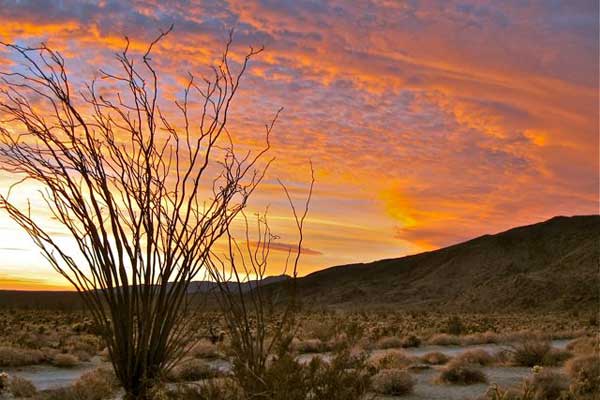
Ocotillo on Tubb Canyon Bajada
at dawn, looking southeast on 10-4-2006.
April 2011
Tub Canyon residents rally to fight mustard
Borrego Sun - 14 April 2011 - Page 10
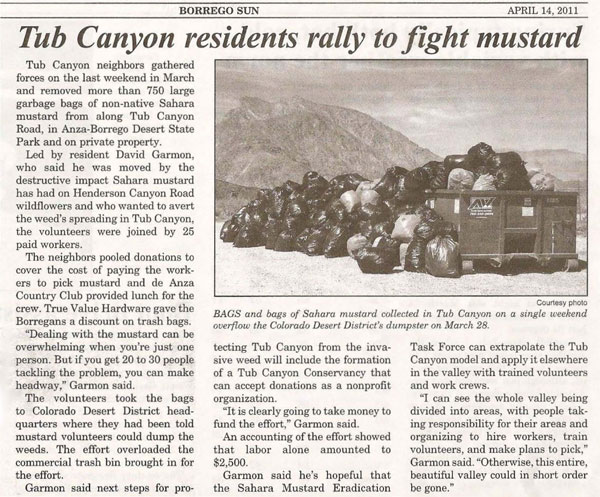
Tub Canyon neighbors gathered forces on the last weekend in March and removed more than750 large garbage bags of non-native Sahara mustard from along Tub Canyon Road, in Anza-Borrego Desert State Park and on private property.
Led by resident David Garmon, who said he was moved by the destructive impact Sahara mustard has had on Henderson Canyon Road wildflowers and who wanted to avert the weed's spreading in Tub Canyon, the volunteers were joined by 25 paid workers.
The neighbors pooled donations to cover the cost of paying the workers to pick mustard and de Anza Country Club provided lunch for the crew. True Value Hardware gave the Borregans a discount on trash bags.
"Dealing with the mustard can be overwhelming when you're just one person, but if you get 20 to 30 people tackling the problem, you can make headway," Garmon said.
The volunteers took the bags to Colorado Desert District headquarters where they had been told mustard volunteers could dump the weeds. The effort overloaded the commercial trash bin brought in for the effort.
Garmon said next steps for protecting Tub Canyon from the invasive weed will include the formation of a Tub Canyon Conservancy that can accept donations as a non-profit organization.
"It is clearly going to take money to fund the effort," Garmon said.
An accounting of the effort showed that labor alone amounted to $2,500.
Garmon said he's hopeful that the Sahara Mustard Eradication Task Force can extrapolate the Tub Canyon model and apply it elsewhere in the valley with trained volunteers and work crews.
"I can see the whole valley being divided into areas, with people taking responsibility for their areas and organizing to hire workers, train volunteers, and make plans to pick," Garmon said. "Otherwise, this entire, beautiful valley could in short order be gone."
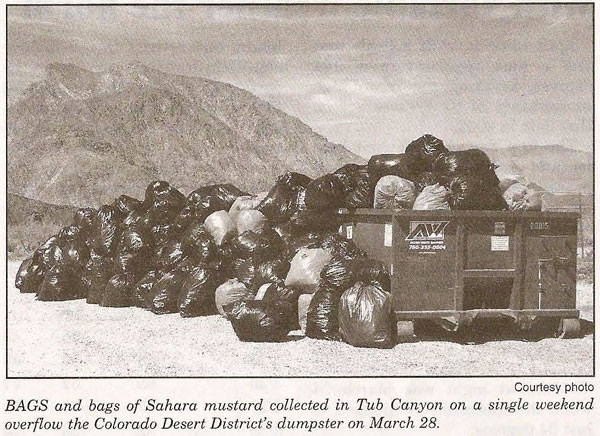
(Posted 11-13-2011)
*Special Note: There has been a long running, cordial disagreement between the Borrego Sun and Tubb Canyon landowners regarding the proper spelling of "Tubb Canyon." Since the late 1990s the newspaper has insisted on spelling the location with only one "b." However, local residents, historical records and numerous maps, including the USGS California Tubb Canyon Quadrangle, spell the place name "Tubb Canyon" with two "b's."
According to Diana Lindsay in her book, Anza-Borrego A-Z: People, Places, and Things (2001):
"Luis Stein, in San Diego Place-Names (1975) states that cattleman Alfred Wilson (a tall, grizzled rancher born in 1888) said that he installed a water pipe in Tubb Canyon to supply water for his cattle. At the end of the pipe, he had a sunken wooden tub, which led to the name of the canyon. When asked why the canyon's name has two `b's,' he is recorded as saying, `I reckon some map fellers are poor spellers.' "
Local folks reckon it was probably the cowboys who were poor spellers. Regardless, Tubb Canyon is how TCDC spells it.
